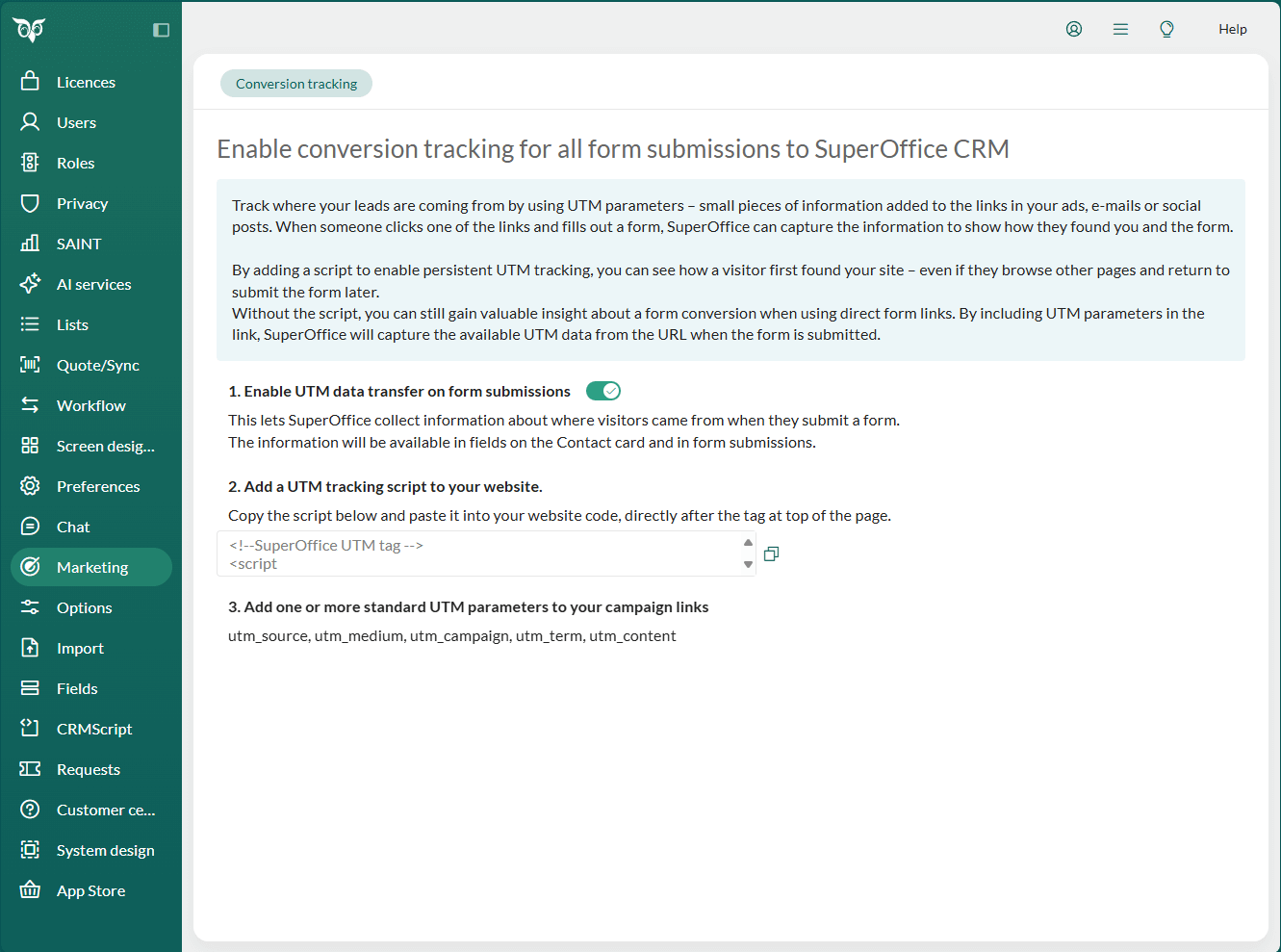Set up UTM tracking
UTM tracking lets SuperOffice capture the source, medium, and campaign that generated a lead. This setup ensures that every form submission can be traced back to the marketing activity that drove it.
You need to complete a one-time setup (by an administrator or web developer) and perform a few recurring steps for each campaign.
Step overview
| Step | Who | Frequency | Purpose |
|---|---|---|---|
| 1. Enable UTM data transfer | Administrator | One time | Allow forms to capture UTM data and store it in CRM fields. |
| 2. Add the UTM tracking script to your website | Web developer | One time | Enable persistent UTM tracking across pages and sessions. |
| 3. Create UTM-tagged campaign links | Marketer | For each campaign | Identify where traffic originates. |
| 4. Apply the UTM link in campaigns | Marketer | For each campaign | Use the tagged links across ads, emails, and social media. |
| 5. Publish your form correctly | Marketer | For each campaign | Ensure your form is published in a way that captures UTM data. |
| 6. Test and verify the setup | Marketer | After initial setup and before each campaign | Confirm that tracking and data capture work correctly. |
| 7. Analyze and visualize results | Marketer | After each campaign | Measure campaign performance in dashboards and reports. |
1. Enable UTM data transfer
Who: Administrator
When: One time
Enabling UTM data transfer lets SuperOffice collect information about where visitors came from when they submit a form.
The data becomes available on both the contact card and form submission records.
Go to Settings and maintenance > Marketing.
Turn on Enable UTM data transfer on form submissions.

2. Add the UTM tracking script to your website
Who: Web developer or person managing your website
When: One time
This script enables persistent tracking. It listens for UTM parameters in the URL and stores them temporarily in the browser, so even if a visitor browses several pages before submitting a form, the first touch data is still recorded.
- Copy the script below.
- Paste it into your website's code directly after the
<head>tag. - Publish the updated page.
<!-- SuperOffice UTM tag -->
<script src="https://sod2.superoffice.com/CustXXXXX/cs/javascript/utm.js"></script>
Tip
Without the script, UTM data is still captured for direct form links but not for visitors who navigate between pages before submitting.
3. Create UTM-tagged campaign links
Who: Marketer
When: For each campaign
UTM parameters identify where your visitors come from, and how they engage with your campaigns.
You can add these parameters manually or use a UTM builder tool.
https://yourcompany.com/signup?utm_source=linkedin&utm_medium=social&utm_campaign=webinar_sept
Use the SuperOffice UTM builder for form pages or Google's Campaign URL Builder to generate consistent campaign URLs and reduce manual errors.
Standard parameters:
utm_source, utm_medium, utm_campaign, utm_term, utm_content
For descriptions and naming conventions, see UTM parameters.
4. Apply the tagged URL in your campaigns
Who: Marketer
When: For each campaign
Use the tagged link wherever you promote your campaign, such as:
- Blog call-to-action buttons
- Email newsletters
- Facebook ads or retargeting
- Google Ads
- LinkedIn posts
5. Publish your form correctly
Who: Marketer
When: For each campaign
SuperOffice can capture UTM data whether your form is embedded on your website or hosted by SuperOffice.
| Method | Description | Captures first touch? |
|---|---|---|
| Embedded form | Add the tracking script to your site and use a landing page URL with UTM tags. | Yes |
| SuperOffice-hosted form (direct link) | Add UTM parameters to the SuperOffice form URL. | No |
Tip
Do not link directly from your website to a SuperOffice-hosted form, as UTM tags will be lost between pages.
6. Test and verify the setup
Who: Marketer
When: After initial setup and before each new campaign
- Click one of your campaign links.
- Fill out and submit the form.
- Open the new contact card in SuperOffice.
- Confirm that the source, medium, and/or campaign fields contain data.
If data is missing, check that:
- The tracking script is correctly installed.
- The UTM parameters are spelled and formatted properly.
- The browser cookies are not blocked or cleared between visits.
7. Analyze and visualize results
Who: Marketer
When: After each campaign
Once data is captured, you can measure performance in dashboards and reports.
- View new leads by first touch source (which channel generated traffic).
- View new leads by campaign (which campaign generated conversions).
- Build a dashboard tile showing new leads by source, medium, or campaign for the current year.
Learn more about dashboards in Marketing dashboards and reports.